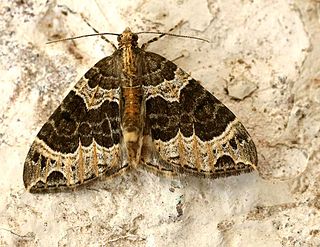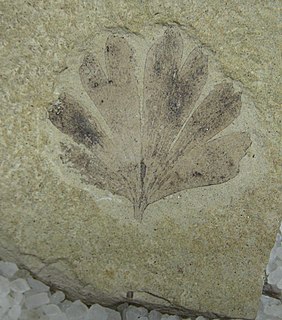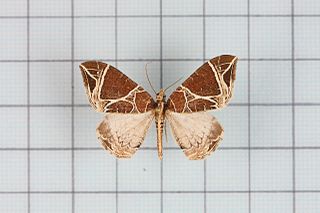Rena dissecta, also known as New Mexico blind snake or New Mexico threadsnake, is a harmless species of blind snake found in the Southwest and southern United States and northern Mexico.

The Cidariini are the largest tribe of geometer moths in the subfamily Larentiinae. The Cidariini include many of the species known as "carpets" or, ambiguously, "carpet moths", and are among the few geometer moths that have been subject to fairly comprehensive cladistic study of their phylogeny. The tribe was described by Philogène Auguste Joseph Duponchel in 1845.

Grevillea pilosa is a low growing shrub which is endemic to the south-west of Western Australia. It grows to between 0.4 and 1 metre in height and produce red or pink flowers between June and December in its native range.

Ecliptopera capitata is a moth of the family Geometridae. The species can be found in Europe.

Ecliptopera silaceata, the small phoenix, is a moth of the family Geometridae. The species was first described by Michael Denis and Ignaz Schiffermüller in 1775.

Dictyestra is a monotypic moth genus of the family Noctuidae erected by Shigero Sugi in 1982. It contains only one species, Dictyestra dissectus, the angle network armyworm, first described by Francis Walker in 1865. It is found from India to Indochina, Sri Lanka, China, Japan, Sundaland and the Philippines and from Sulawesi to the Moluccas and New Guinea.

Ecliptopera is a genus of moths in the family Geometridae.

Ecliptopera rectilinea is a species of moth of the family Geometridae first described by William Warren in 1894. It is found in the north-eastern parts of the Himalayas, Taiwan, northern Thailand, Peninsular Malaysia, Borneo, Bali, Sumbawa and Sulawesi.

Ginkgo dissecta is an extinct ginkgo species in the family Ginkgoaceae described from a series of isolated fossil leaves. The species is known from Early Eocene sediments exposed in the province of British Columbia, Canada, and Washington, USA. It is one of two Ginkgo species found at the Washington and British Columbia sites.

Ecliptopera benigna is a moth of the family Geometridae first described by Louis Beethoven Prout in 1914. It is found in Taiwan.

Ecliptopera muscicolor is a moth of the family Geometridae. It was described by Frederic Moore in 1888. It is found in India, Sri Lanka and Taiwan.
Lactuca dissecta, the split-leaf lettuce, is an Asian species of plant in the dandelion tribe within the sunflower family. It is native to Central Asia, western China, the Himalayas, and southwest Asia as far west as Turkey.
Niebla dissecta is a fruticose lichen that grows on rocks along the Pacific Coast of California, in San Mateo County and in the Channel Islands. The epithet, dissecta is in reference to the thallus repeatedly divided into branches.

Ecliptopera atricolorata, the dark-banded geometer moth, is a moth of the family Geometridae. It is found in North America, where it has been recorded from Alabama, Arkansas, Florida, Georgia, Indiana, Kentucky, Maryland, Mississippi, North Carolina, Ohio, Pennsylvania, South Carolina, Tennessee, Virginia and West Virginia.

Amauriopsis dissecta is a North American species of flowering plants in the daisy family known by the common names yellow ragweed and ragleaf bahia. It is native to the western United States as far north as the Black Hills of South Dakota and Wyoming, as well as in northern Mexico.
Epimactis dissecta is a moth in the family Lecithoceridae. It was described by Edward Meyrick in 1921. It is found on Java in Indonesia.
Ecliptopera subnubila is a moth of the family Geometridae.
Falagria dissecta is a species of rove beetle in the family Staphylinidae. It is found in North America.
Rhadine dissecta is a species of ground beetle in the family Carabidae. It is found in North America.

Xystocheir dissecta is a species of flat-backed millipede in the family Xystodesmidae. It is found in North America.











